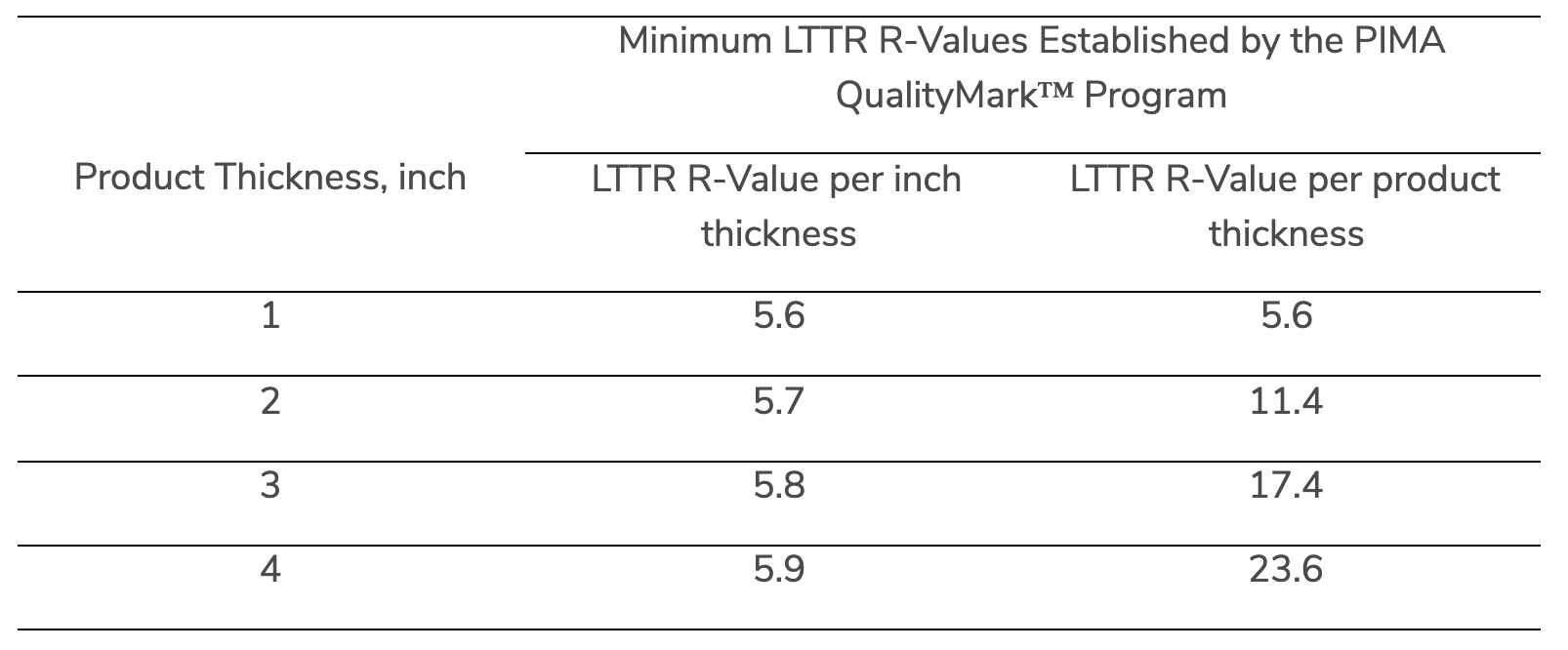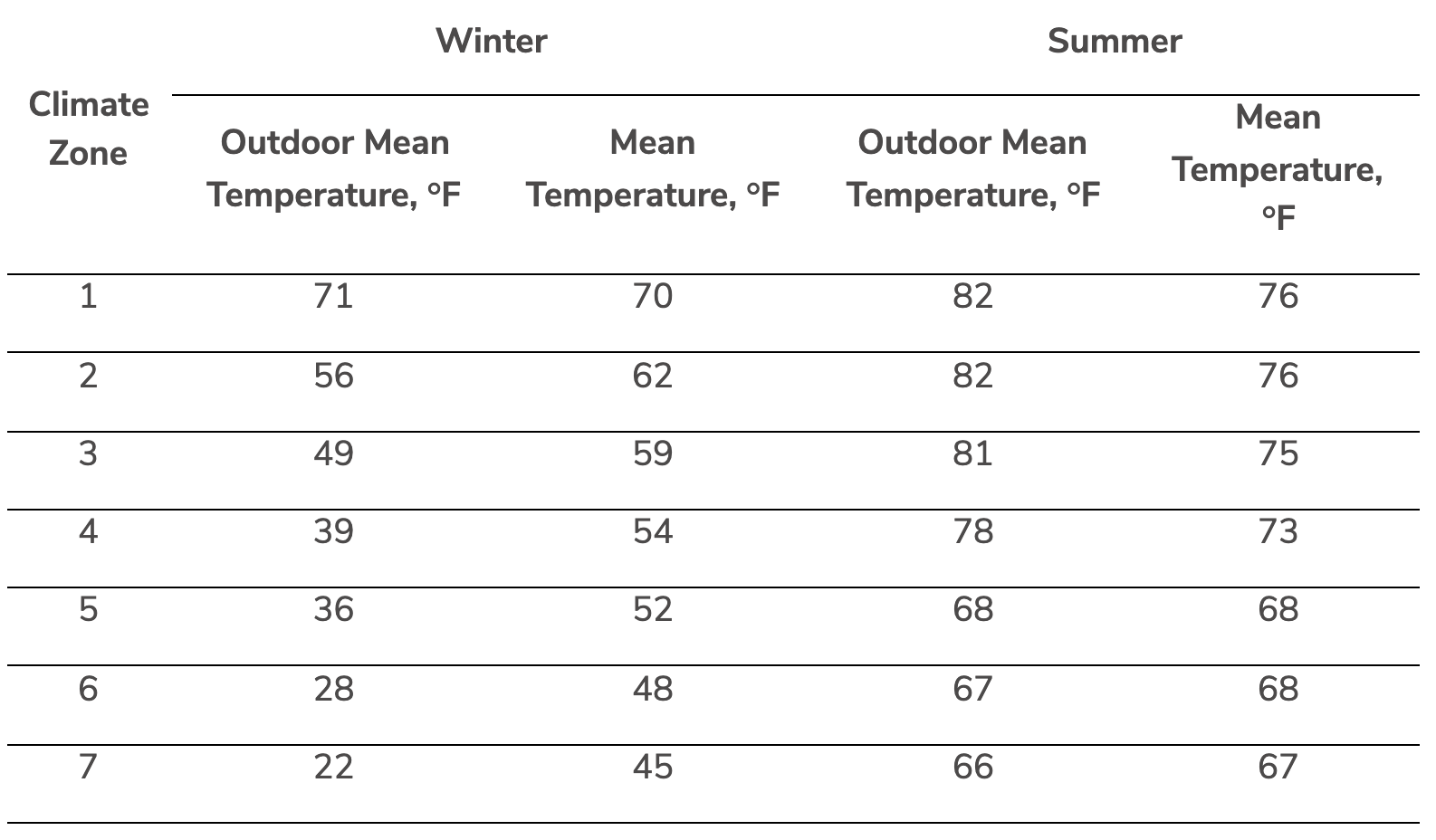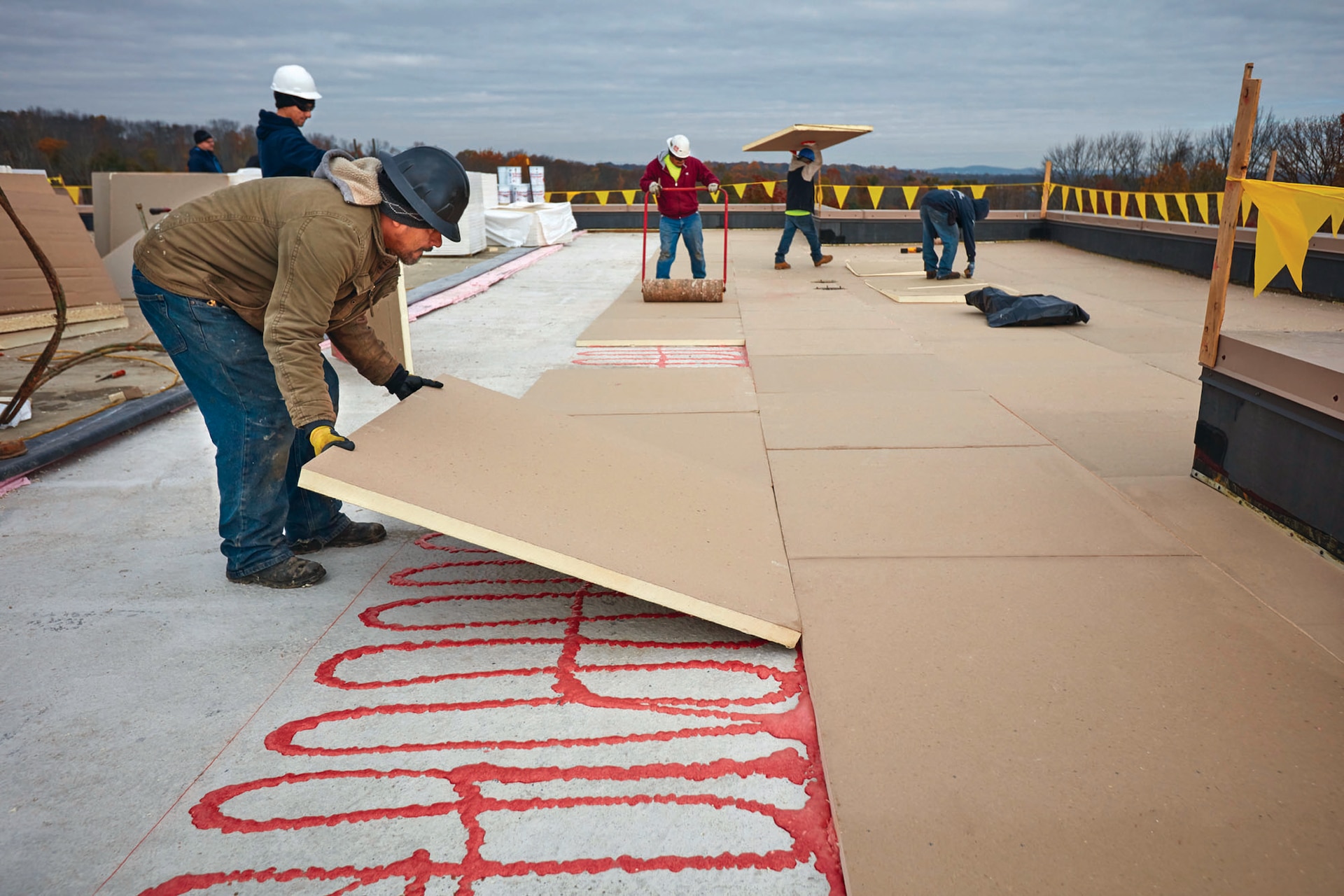El aislante térmico es una parte importante de los sistemas de techos comerciales. El objetivo de este artículo es examinar los factores que influyen en la resistencia térmica del poliisocianurato, lo que se conoce como valor R. La predicción del valor R a largo plazo y la influencia del clima, es decir, la temperatura, han sido temas de gran interés en las últimas décadas, ya que los presupuestos energéticos de los edificios han cobrado mayor relevancia. Se revisan y analizan las discusiones recientes sobre qué valor R debe utilizar el diseñador y la importancia de la temperatura ambiente.
- La espuma de poliisocianurato es hoy el tipo de aislante más común debido a su alto valor R por pulgada, sus propiedades de resistencia al fuego y su resistencia a solventes.
- El poliisocianurato bloquea el flujo de aire, lo que reduce el riesgo de condensación en comparación con los aislantes permeables al aire.
- El mayor beneficio del poliisocianurato se observa durante los meses de verano, cuando el uso del aire acondicionado es más alto. La electricidad es cuatro veces más costosa que el gas en términos de BTU equivalentes. Esto hace que el impacto del aire acondicionado sea mayor que el de la calefacción en invierno.
Introducción
Evitar la intrusión de agua en el entorno construido durante una precipitación siempre se ha considerado la función básica del techo. Sin embargo, reducir el flujo de calor a través del cerramiento del edificio es una función secundaria muy importante. Mantener el confort térmico interior siempre ha sido una parte importante de la construcción residencial, pero no fue sino hasta principios de los años 1970 que el uso de plataformas base de acero térmicamente aisladas se volvió común en la construcción comercial, debido a la necesidad de reducir los costos energéticos del edificio.
El aislante térmico de poliisocianurato, comúnmente conocido como poliisocianurato, ha demostrado ser popular debido a una combinación de rentabilidad (es decir, costo por unidad de aislante), eficiencia (es decir, valor aislante por unidad de espesor) y resistencia al fuego, en comparación con otros materiales competidores. Recientemente, el poliisocianurato ha llegado a representar más del 75% del mercado de aislante para techos comerciales. Sin embargo, a medida que el poliisocianurato ha ido ganado popularidad, también ha aumentado el interés por comprender con mayor precisión su valor aislante. Con el aumento de los costos energéticos, es más importante especificar con precisión los equipos de calefacción, ventilación y aire acondicionado (HVAC). Además, una vez que se completa un edificio, es importante que el propietario/usuario pueda anticipar mejor los futuros costos energéticos desde una perspectiva presupuestaria.
Cómo se fabrica el poliisocianurato
Con cualquier material aislante en espuma, el proceso comienza con los materiales precursores plásticos o poliméricos en fase líquida. Se introduce un agente espumante gaseoso ya sea mediante algún tipo de inyección en el proceso o a través de reacciones químicas que crean la matriz polimérica. Inicialmente, el/los agente(s) espumante(s) se encuentra(n) en una dispersión sumamente fina. En el caso del poliisocianurato, se utiliza pentano como agente espumante y, durante el desarrollo posterior de la matriz, se libera calor. El calor hace que el pentano disperso se expanda, lo que forma celdas gaseosas. El crecimiento de estas celdas da lugar finalmente a la colisión entre celdas, proceso que se indica esquemáticamente a continuación:
Cuando las celdas colisionan, la tensión superficial tiende a adelgazar el material entre dos celdas y a engrosar el material entre múltiples celdas. Esto da lugar a las llamadas ventanas y viguetas celulares, como se indica aquí:
Las características de las ventanas y viguetas, como el grosor, tamaño y cantidad, influyen en la resistencia térmica total de la espuma, junto con la composición del gas espumante, como se analizará más adelante.
Las principales características del poliisocianurato son:
- Las celdas están cerradas en un 99%. Esto significa que la humedad no se condensa dentro del poliisocianurato y que se limita la difusión del aire cargado de humedad a través del armado del techo.
- El material celular, es decir, el polímero, representa menos del 5% del volumen total de la espuma. Cuando se dice que transportar poliisocianurato es como transportar aire, es porque el 95% del peso corresponde al gas dentro de las celdas.
- El material es termoestable: en caso de incendio, no se derrite ni gotea a través de aberturas en la cubierta del techo. Además, no se ve afectado por solventes, a diferencia de otras espumas como el poliestireno.
Cómo aísla el poliisocianurato
El calor puede viajar a través de un material espumado de tres maneras: conducción, convección y radiación, como se muestra esquemáticamente a continuación.
Conducción: las espumas de celda cerrada, como el poliisocianurato, están formadas por celdas poliméricas y el gas contenido en ellas.
- El material celular, es decir, el polímero, representa menos del 5% del volumen total de la espuma y, por lo tanto, su conducción térmica representa solo una fracción menor de la transferencia total de calor. Además, el camino a lo largo del polímero desde el lado caliente al lado frío es intrincado. Los fabricantes buscan lograr una baja densidad de espuma y la conducción a través del polímero generalmente se considera insignificante.
- La mezcla gaseosa dentro de las celdas representa más del 95% del volumen total de la espuma. Esa fase gaseosa representa prácticamente toda la conducción térmica a través del poliisocianurato. El agente espumante utilizado para crear la espuma tiene cierta conductividad; sin embargo, con el tiempo, ese agente puede difundirse fuera de la espuma y el aire puede ingresar. La difusión de gases hacia dentro y fuera del poliisocianurato es más lenta que en otras espumas poliméricas, como las de base de poliestireno.
Convección es la transferencia de calor debida al movimiento en masa de moléculas dentro de fluidos como gases y líquidos, desde una superficie caliente hacia una más fría. En espumas como el poliisocianurato, las celdas son demasiado pequeñas para que ocurra convección. Además, la diferencia de temperatura a través de cada celda individual es demasiado pequeña para provocar convección.
Radiación: la energía térmica se irradia desde superficies calientes y es absorbida por los materiales dependiendo de su opacidad y espesor. El poliisocianurato no bloquea totalmente la radiación térmica; se considera que las paredes de las celdas son demasiado delgadas para absorberla, aunque se piensa que las viguetas de las celdas sí la absorben y luego la reirradian. Los fabricantes procuran producir celdas pequeñas, es decir, más celdas por unidad de volumen, para bloquear de forma más eficaz la radiación térmica.
Beneficios del aislante para un techo
El aislante tiene dos efectos principales sobre el flujo de calor hacia dentro y fuera de un edificio.
- Durante el verano, se reduce el flujo de calor del sol hacia el interior del edificio. De manera similar, las membranas reflectantes también reducen la cantidad de calor, pero lo hacen mediante la reflexión. Durante el invierno, el aislante reduce el flujo de calor hacia fuera del edificio, lo que disminuye los costos de calefacción.
- El aislante retrasa el flujo de calor hacia dentro o fuera de un edificio. El poliisocianurato tiene "inercia térmica", a diferencia de, por ejemplo, las membranas reflectantes que no presentan este efecto.
- Para edificios como oficinas, este efecto de retraso es un beneficio muy importante del aislante. Significa que el esfuerzo máximo del sistema de aire acondicionado debido al flujo de calor a través del techo es necesario durante menos horas del día.
Especificación de resistencia térmica
El poliisocianurato se fabrica conforme a la norma ASTM C1289 de especificación estándar para tableros de aislante térmico de poliisocianurato celular rígido revestido. La norma C1289 especifica la resistencia térmica a una temperatura media de 75 °F para varios espesores del producto y exige que los valores a 40 y 110 °F estén disponibles si se solicitan.
Las características importantes de los valores R publicados por el fabricante son:
- Los valores son un promedio de un rango de temperaturas. Los métodos de prueba requieren que la muestra de aislante tenga un lado caliente y un lado frío, con una diferencia mínima de 40 °F entre ambos. Los laboratorios de prueba de mejor reputación usan una diferencia de 50 °F para mayor precisión. Así, un valor publicado a 75 °F es en realidad un valor R promedio en el rango de 50 a 100 °F.
- Para tener en cuenta la difusión de gases hacia fuera de la espuma y la entrada de aire, los valores se basan en la "resistencia térmica a largo plazo" (LTTR) proyectada, obtenida mediante el envejecimiento acelerado de láminas delgadas de espuma.
- A partir de 2003, la Asociación de Fabricantes de Aislamiento de Poliisocianurato (Polyisocyanurate Insulation Manufacturers Association, PIMA) estableció un programa de certificación de terceros para validar de forma independiente los valores LTTR. Esto se conoce como el programa PIMA QualityMark™. Los valores de LTTR se consideran "valores R declarados", para el uso por parte de profesionales de diseño de edificios.
- Los valores R declarados representan un valor promedio ponderado por tiempo de 15 años. Pueden ayudar a un profesional del diseño a estimar la eficiencia energética de un edificio sin tener que preocuparse por la pérdida de rendimiento a largo plazo, ya que este aspecto está contemplado en el valor.
Validación de los valores R en la etiqueta
El programa PIMA QualityMark™ exige a los fabricantes participantes cumplir con los siguientes valores R para los distintos espesores de producto.

El programa PIMA QualityMark™ exige que cada planta de fabricación se someta a una verificación anual de los valores LTTR. Durante la verificación, representantes independientes de terceros visitan cada planta y seleccionan al menos cinco paneles para su prueba. El proceso general es administrado por FM Global. Los resultados de una prueba de verificación PIMA QualityMark realizada en 2015 se resumen a continuación:

En total, se probaron 33 muestras por cada espesor a una temperatura media de 75 °F. Estos valores, obtenidos mediante un proceso independiente de terceros, resultan tranquilizadores, especialmente por la gran cantidad de muestras involucradas (33 muestras x 5 especímenes = 165 pruebas). El programa PIMA QualityMark™ existe para garantizar que los fabricantes miembros cumplan con los valores declarados en sus etiquetas.
Valor R y temperatura
Como se indicó anteriormente, la especificación de la norma ASTM para poliisocianurato exige que el valor a 75 °F sea publicado y que los valores a 40 y 110 °F estén disponibles a pedido. Las temperaturas medias de referencia para las zonas climáticas ASHRAE en condiciones de invierno y verano, asumiendo una temperatura interior de diseño de 68 °F, se muestran aquí:

- A partir de los datos, es evidente que el valor R reportado para una temperatura media de 75 °F es adecuado para el verano, y en muchos casos, también para el invierno.
- Los profesionales del diseño de edificios que trabajan en zonas climáticas ASHRAE 6 y 7 podrían necesitar utilizar el valor R reportado para una temperatura media de 40 °F al evaluar los requisitos de calefacción en invierno.
Además, el costo de la electricidad es aproximadamente cuatro veces el del gas natural, si se considera el equivalente energético en unidades térmicas británicas. Al especificar el aislante, si se utiliza calefacción a gas, los costos del aire acondicionado en verano podrían ser más relevantes, y el valor R a la temperatura media de 75 °F podría ser el más importante.
La "Regla del valor R"
Aunque conocer el valor R de un material es importante para el mercado de edificios comerciales, los especificadores de HVAC y los propietarios/ocupantes de edificios, los propietarios de viviendas y consumidores individuales generalmente no pueden verificar las afirmaciones sobre la resistencia térmica. Tras la crisis energética de los años 1970, las afirmaciones fraudulentas sobre valores R se volvieron tan comunes que el Congreso de EE. UU. aprobó una ley de protección al consumidor en respuesta: la "Regla del valor R". La Regla del valor R "exige a los fabricantes de aislante residencial, instaladores profesionales, vendedores de viviendas nuevas y minoristas proporcionar información sobre el valor R, basada en resultados de pruebas estándar".
El poliisocianurato se utiliza como aislante continuo en sistemas de muros residenciales y ensambles de techos en muchos edificios de departamentos y condominios de gran altura. No es factible para los fabricantes de poliisocianurato diferenciar entre productos destinados a aplicaciones residenciales o comerciales. Por lo tanto, en la práctica, la Regla del valor R cubre todo el poliisocianurato, lo que significa que los valores R indicados en las etiquetas tienen fuerza legal.
Conclusiones
- La conductividad térmica del poliisocianurato, al igual que en la mayoría de las otras espumas, está dominada por la conducción térmica de los gases de las celdas.
- Contrario a lo que se cree, los valores R se informan como un promedio dentro de un rango de temperaturas y no representan un valor a una temperatura exacta. Por ejemplo, el valor R informado a 75 °F normalmente se mide en un rango de 50 a 100 °F y debe interpretarse como un valor R medio.
- Se recomienda a los diseñadores y especificadores de edificios usar los valores R etiquetados para una temperatura media de 75 °F. Para proyectos en las zonas climáticas ASHRAE 6 y 7, podrían usarse valores a 40 °F, según la geometría del edificio y los costos locales de energía.
¿Quieres saber más? Consulta mi artículo reciente en Interface.

